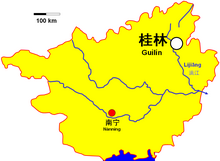| Revision as of 07:56, 13 April 2006 editTom Gibbs (talk | contribs)96 editsm →Li River Scenery← Previous edit | Revision as of 19:56, 17 May 2006 edit undo24.80.225.209 (talk)No edit summaryNext edit → | ||
| Line 25: | Line 25: | ||
| * ] | * ] | ||
| * ] | * ] | ||
| ==Exteral links== | |||
| * | |||
| ] | ] | ||
Revision as of 19:56, 17 May 2006



The Li River (Chinese: 漓江, pinyin: Lí Jiāng) is a river in Guangxi Province, China. (Also see the Li River disambiguation page.)
The Li River originates in the Mao'er Mountains in Xing'an county and flows through Guilin, Yangshuo and Pingle, down into the Xi Jiang, the western tributary of Pearl River in Wuzhou, its course of 437 kilometers is flanked by green hills and beautiful scenery.
Li River Scenery
Along the 100-kilometer stretch of the Li River, mountain peaks rise straight into the sky as if they have pushed up from the ground. It is Guilin, one of China's most famous scenic areas.
The serene mountains, sparkling waters, and exotic rocks typical of the karst landmass in the Li River basin have inspired the saying: "The landscape of Guilin is unmatched under heaven." The 83 kilometers of the Lijiang River from Guilin to Yangshuo form an outstanding feature of the beautiful landscape in Guilin.
- Reed-Flute Rock: a wonderful limestone cave with a large number of stalactites, stalagmites, stalacto-stalagmites, rocky curtains, and cave corals.
- Seven-Star Park: the largest park in Guilin.
- Mountain of Splendid Hues: consists of many layers of variously colored rocks.
- Elephant-Trunk Hill: looks very much like a giant elephant drinking water with its trunk. It is symbol of the city of Guilin.
- Lingqu Canal: dug in 214 B.C., is one of the three big water conservation projects of ancient China and the oldest existing canal in the world.
- Other attractions include: Duxiu Peak, Nanxi Park, the Taohua River, the Giant Banyan, and the Huashan-Lijiang National Folklore Park.
The beautiful imagery of the Li River is featured on the 20 yuan note (see photo).